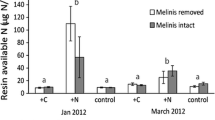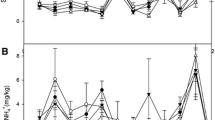Abstract
Increased nitrogen (N) deposition, resulting from the combustion of fossil fuels, production of synthetic fertilizers, growth of N2-fixing crops and high-intensity agriculture, is one of the anthropogenic factors most likely to cause global biodiversity changes over the next century. This influence may be especially large in temperate zone forests, which are highly N limited and occur in regions with the highest levels of N deposition. Within these ecosystems, N2-fixing plants, including legumes, may be more sensitive to N deposition than other plant species. Though it has long been recognized that the competitive edge conferred by N2-fixation diminishes with increasing soil N availability, the conservation implications of increased N deposition on native N2-fixers have received less attention. We focus on Desmodium cuspidatum, which has experienced dramatic population losses in the last 30–40 years in the northeastern United States. We explore competition between this regionally threatened legume and a common non-N2-fixing neighbor, Solidago canadensis, across a gradient of N deposition. Our data show that increased N deposition may be detrimental to N2-fixers such as D. cuspidatum in two ways: (1) biomass accumulation in the non-N2-fixer, S. canadensis, responds more strongly to increasing N deposition, and (2) S. canadensis competes strongly for available mineral nitrogen and can assimilate N previously fixed by D. cuspidatum, resulting in D. cuspidatum relying more heavily on energetically expensive N2-fixation when grown with S. canadensis. N deposition may thus reduce or eliminate the competitive advantage of N2-fixing species growing in N-limited ecosystems.



Similar content being viewed by others
References
Armstrong EL, Heenan DP, Pate JS, Unkovich MJ (1997) Nitrogen benefits of lupins, field pea, and chickpea to wheat production in south-eastern Australia. Aust J Agric Res 48:39–47
Bobbink R, Hornung M, Roelofs JGM (1998) The effects of air-borne nitrogen pollutants on species diversity in natural and semi-natural European vegetation. J Ecol 86:717–738
Boddey RM, Peoples MB, Palmer B, Dart P (2000) Use of the N-15 abundance technique to quantify biological nitrogen fixation by woody perennials. Nutr Cycl Agroecosyst 57:235–270
Campbell JL, Hornbeck JW, McDowell WH, Buso DC, Shanley JB, Likens GE (2000) Dissolved organic nitrogen budgets for upland, forested ecosystems in New England. Biogeochemistry 49:123–142
Chambers C, Smith S, Smith F (1980) Effects of ammonium and nitrate ions on mycorrhizal infection, nodulation and growth of Tribolium subterraneum. New Phytol 85:47–62
Dawson TE, Mambelli S, Plamboeck AH, Templer PH, Tu KP (2002) Stable isotopes in plant ecology. Annu Rev Ecol Syst 33:507–559
Driscol CT, Whitall D, Aber JD, Boyer E, Castro M, Cronan C, Goodale C, Groffman P, Hpokinson C, Lambert K, Lawerence G, Ollinger S et al (2003) Nitrogen pollution in the Northeastern United States: sources, effects, and management options. Bioscience 53:357–374
Emmett BA (2007) Nitrogen saturation of terrestrial ecosystems: some recent findings and their implications for our conceptual framework. Water Air Soil Pollut Focus 7:99–109
Fenn ME, Poth MA, Aber JD, Baron JS, Bormann BT, Johnson DW, Lemly AD, McNulty SG, Ryan DG, Stottlemyer R (1998) Nitrogen excess in North American ecosystems: predisposing factors, ecosystem responses, and management strategies. Ecol Appl 8:706–733
Foster DR, Aber JD (2004) Forests in time: the environmental consequences of 1,000 years of change in New England. Yale University Press, New Haven
Frame J (2006) Herbage production and quality of a range of secondary grass species at five rates of fertilizer nitrogen application. Grass Forage Sci 46:139–151
Galloway JN, Aber JD, Erisman JW, Seitzinger SP, Howarth RW, Cowling EB, Crosby BJ (2003) The nitrogen cascade. Bioscience 53:341–356
Gleason HA, Cronquist A (1991) Manual of vascular plants of northeastern United States and adjacent Canada, 2nd edn. New York Botanical Garden, Bronx
Gotelli NJ, Ellison A,M (2002) Nitrogen deposition and extinction risk in the northern pitcher plant, Sarracenia purpurea. Ecology 83:2758–2765
Gruber N, Galloway JN (2008) An earth-system perspective of the global nitrogen cycle. Nature 451:293–296
Hansen AP (1994) Symbiotic N2 fixation of crop legumes, achievements and perspectives.Engelhardt, Neunkirchen
Harper L (2002) Desmodium cuspidatum (Muhl.) Loudon, large-bracted tick-trefoil, conservation and research plan for New England. New England Wildflower Society, Framingham
Hauck R (1990) Agronomic and public aspects of soil nitrogen research. Soil Use Manage 6:66–70
Heil GW, Diemont WH (1983) Raised nutrient levels change heathland into grassland. Plant Ecol 53:113–120
Herridge DF, Pate JS (1977) Utilization of net photosyntheate for nitrogen fixation and protein production in an annual legume. Plant Physiol 60:564–759
Herridge DF, Marcellos H, Felton WL, Turner GL, Peoples MB (1995) Chickpea increases soil-N fertility in cereal systems through nitrate sparing and N2 fixation. Soil Biol Biochem 27:545–551
Hoagland DR, Arnon DI (1950) The water-culture method for growing plants without soil. College of Agriculture, University of California, Berkeley
Holland EA, Dentener FJ, Braswell BH, Sulzman JM (1999) Contemporary and pre-industrial global reactive nitrogen budgets. Biogeochemistry 46:7–43
Houdijk ALFM, Verbeek PJM, Van Dijk HFG, Roelofs JGM (1993) Distribution and decline of endangered herbaceous heathland species in relation to the chemical composition of the soil. Plant Soil 148:137–143
Jensen ES (1996) Rhizodeposition of N by pea and barley and its effect on soil N dynamics. Soil Biol Biochem 28:65–71
Jones ML, Wallace HL, Norris D, Brittain SA, Haria S, Jones RE, Rhind PM, Reynolds BR, Emmett BA (2004) Changes in vegetation and soil characteristics in coastal sand dunes along a gradient of atmospheric nitrogen deposition. Plant Biol 6:598–605
Kurdali F, Domenach AM, Bardin R (1990) Alder-poplar associations: determination of plant nitrogen sources by isotope techniques. Biol Fertil Soils 9:321–329
Lee JA (1998) Unintentional experiments with terrestrial ecosystems: ecological effects of sulphur and nitrogen pollutants. J Ecol 86:1–12
Leidi E, Rodriguez-Navarro D (2000) Nitrogen and phosphorus availability limit N2 fixation in bean. New Phytol 147:337–346
Likens GE (2004) Some perspectives on long-term biogeochemical research from the Hubbard Brook ecosystem study. Ecology 85:2355–2362
Likens GE, Bormann FH (1995) Biogeochemistry of a forested ecosystem, 2nd edn. Springer, New York
Lindemann WC, Glover CR (2003) Nitrogen fixation by legumes. Cooperative Extension Service, New Mexico State University, Las Cruces
Loehle C (2003) Competitive displacement of trees in response to environmental change or introduction of exotics. Environ Manage 32:106–155
NADP (2004) National atmospheric deposition program. http://nadp.sws.uiuc.edu/. Accessed Nov 2004
NADP (2008) National atmospheric deposition program. http://nadp.sws.uiuc.edu/. Accessed March 2008
NatureServe (2007) NatureServe. http://www.natureserve.org/. Accessed Oct 2007
NatureServe (2010) NatureServe. http://www.natureserve.org/explorer. Accessed June 2010
Ollinger S, Aber JD, Lovett GM, Millham SE, Lathrop RG, Ellis JM (1993) A spatial model of atmospheric deposition for the Northeastern US. Ecol Appl 3:459–472
Pennings SC, Clark CM, Cleland EE, Collins SL, Gough L, Gross KL, Milchunas DG, Suding KN (2005) Do individual plant species show predictable responses to nitrogen addition across multiple experiments? Oikos 110:547–555
Sala OE, Chapin FS III, Armesto JJ, Berlow E, Bloomfield J, Dirzo R, Huber-Sanwald E, Nuenneke LF, Jackson RB, Kinzing A, Leemans R, Lodge DM, Mooney HA, Oesterheld M, Poff NL, Sykes MT, Walker BH, Walker M, Wall DH (2000) Global biodiversity scenarios for the year 2100. Science 287:1770–1774
Shearer G, Kohl DH (1989) Estimates of N2 fixation in ecosystems: the need for and basis of the 15N natural abundance method. Springer, New York
Skogen KA (2008) Declining Desmodium cuspidatum (Muhl.ex Willd.) DC. Ex Loudon, multiple approaches to a unique conservation problem. PhD dissertation, University of Connecticut, Storrs
Smart SM, Bunce RG, Marrs R, LeDuc M, Firbank LG, Maskell LC, Scott WA, Thompson K, Walker KJ (2005) Large-scale changes in the abundance of common higher plant species across Britain between 1978, 1990 and 1998 as a consequence of human activity: tests of hypothesised changes in trait representation. Biol Conserv 124:355–371
Stevens CJ, Dise NB, Mountford JO, Gowing DJ (2004) Impact of nitrogen deposition on the species richness of grasslands. Science 303:1876–1879
Streeter J (1988) Inhibition of legume nodule formation and N2 fixation by nitrate. Crit Rev Plant Sci 7:1–23
Suding KN, Collins SL, Gough L, Clark C, Cleland EE, Gross KL, Milchunas DG, Pennings S (2005) Functional- and abundance-based mechanisims explain diversity loss due to N fertilization. Proc Nat Acad Sci USA 102:4387–4392
R Development Core Team (2006) R: a language and environment for statistical computing. R Foundation for Statistical Computing, Vienna. ISBN 3-900051-07-0. http://www.R-project.org
Temperton VM, Mwangi PN, Scherer-Lorenzen M, Schmid B, Buchmann N (2007) Positive interactions between nitrogen-fixing legumes and four different neighboring species in a biodiversity experiment. Oecologia 151:190–205
Thomas RB, Bashkin MA, Richter DD (2000) Nitrogen inhibition of nodulation and N2 fixation of a tropical N2-fixing tree (Gliricidia sepium) grown in elevated atmospheric CO2. New Phytol 145:233–243
Vitousek PM, Mooney HA, Lubchenco J, Melillo JM (1997) Human domination of earth’s ecosystems. Science 277:494–499
Waterer JG, Vessey JK (1993) Effect of low static nitrate concentrations on mineral nitrogen uptake, nodulation and nitrogen fixation in field pea. J Plant Nutr 16:1775–1789
Wedin DA, Tilman D (1996) Influence of nitrogen loading and species composition on the carbon balance of grasslands. Science 274:1720–1723
Acknowledgments
We thank G. Likens, R. Chazdon, G. Anderson, P. Templer, P. Herron, N. Wickett, R. Prunier, K. Theiss and J. Carlson for comments on previous drafts of this manuscript and C. Casile for greenhouse assistance with experimental set up and data collection. Special thanks to the following for assistance cleaning belowground biomass samples: J. Budke, C. Casile, C. Fyler, C. Gjerdrum, N. Hax, K. Hill, J. Hill, S. Marty, H. McManus, B. O’Donnell, M. Polihronakis, R. Prunier, F. Reyda, N. Ross, K. Sturgeon, N. Tabak, K. Theiss, N. Tippery, N. Wickett and G. Yanega. This work is part of a dissertation submitted in partial fulfillment of the requirements for the degree of Doctor of Philosophy at the University of Connecticut. Funding was provided by The Center for Conservation and Biodiversity at the University of Connecticut, The National Science Foundation Doctoral Dissertation Improvement Grant (DEB-0608243) and The United States Environmental Protection Agency (EPA) under the Science to Achieve Results Graduate Fellowship Program. EPA has not officially endorsed this publication and the views herein may not reflect the views of the EPA. The authors declare that there is no conflict of interest. The experiment conducted complies with the current laws in the United States.
Author information
Authors and Affiliations
Corresponding author
Additional information
Communicated by Jon Keeley.
Rights and permissions
About this article
Cite this article
Skogen, K.A., Holsinger, K.E. & Cardon, Z.G. Nitrogen deposition, competition and the decline of a regionally threatened legume, Desmodium cuspidatum . Oecologia 165, 261–269 (2011). https://doi.org/10.1007/s00442-010-1818-7
Received:
Accepted:
Published:
Issue Date:
DOI: https://doi.org/10.1007/s00442-010-1818-7




